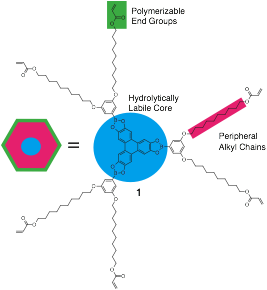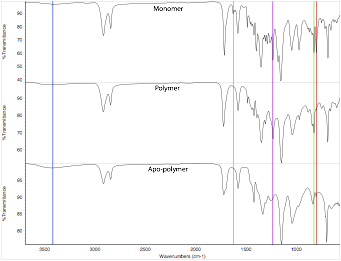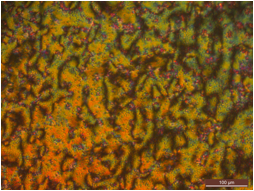Reports: ND755752-ND7: Nanoporous Membranes by Network Polymerization of Discotic Liquid Crystalline Monomers
Benjamin T. King, University of Nevada (Reno)
Our approach to nanoporous membranes relies on columnar mesophases of discotic liquid crystals to template linear, homeotropic pores. Our monomers are based upon boronic ester containing DLCs that are known to form columnar mesophases. Network polymerization of acrylate-bearing side arms on a monomer crosslinks the DLCs to form the polymer while preserving the essential columns. The boronic ester linkages are then hydrolyzed, freeing the aromatic cores from the polymerized film and producing the desired membrane, called the apo-polymer.
Our first monomer 1 was tailored to contain a hydrolytically labile aromatic core functionalized with peripheral alkyl chains terminated by polymerizable end groups (figure 1). 1 was synthesized in four steps with a 26% overall yield from commercially available material (scheme 1).
Figure 1. Monomer 1 detailing key structural features.
Scheme 1. Synthesis of 1. [a] K2CO3, DMF, reflux, 18 h, 70%. [b] Pd-XPhos-G2, XPhos, B2(OH)4, KOAc, EtOH, 70 °C, 3 h, 90%. [c] NEt3, acryloyl chloride, THF, RT, 3 h, 75%. [d] HHTP, MeCN, RT, 24 h, 53%.
Differential scanning calorimetry (DSC) revealed a mesophase from <30-55 °C for 1 and that polymerization occurs from around 150 °C. 1 was found to align with what we believed to be a high degree of homeotropicity because it produces a mostly black image when viewed under polarized optical microscopy (POM) (scheme 2, middle left). To confirm that 1 was indeed aligned in a LC mesophase and not in some isotropic or amorphous state, a push test was performed where the sample is manually disturbed while observed under cross polarizers. The appearance of birefringence in the sample during this disturbance indicates the presence of a LC mesophase, which was the case with 1.
Scheme 2. Membrane synthesis with corresponding POM (middle) images. Differential interference contrast images (bottom) show sample present under POM.
1 was aligned between glass slides then irradiated under ambient conditions for 72 hours with 300 nm light. Polymer 5 also showed a mostly black image with POM (scheme 2, center). The film can be manually removed from one or both glass surfaces to produce either a supported or freestanding film depending on what is desired. IR of 5 showed greater than 95% polymerization. Soaking 5 in a 0.1 M solution of HCl in methanol for 3 days at 40 °C freed the aromatic cores from the polymer membrane, yielding apo-polymer 6. Subsequent washings with 0.1 M aqueous HCl then water ensured the pores were free from any methanol and lined with free boronic acids. Films of 6 maintained similar visual appearance via POM as 1 and 5 but with slightly more imperfections (scheme 3, middle right). The hexahydroxytriphenylene removed from the membrane was quantified by UV-vis spectrophotometry and IR spectroscopy (figure 2). TEM of polymer 5 showed what appeared to be random order in contrast to what we now know to be misinterpreted POM and X-ray diffraction data. This motivated us to prepare a new monomer with shorter alkyl chains, reducing the induced fluid character and hopefully lead to a more ordered material.
Figure 2. A reduction in the peaks at 1634 cm−1 (orange, acrylate C=C stretch) and 808 cm−1 (red, acrylate =CH2 wag) indicate polymerization of end groups upon photo irradiation of monomer 1 (top) to form polymer 5 (middle). The appearance of a broad O-H stretch peak centered around 3430 cm−1 (blue) and loss of peaks at 1238 cm−1 (purple, triphenylene C-O stretch) and 837 cm−1 (green, triphenylene C-H out of plane bend) indicate removal of the triphenylene core from polymer 5 (middle) to form apo-polymer 6 (bottom).
Figure 3. TEM of polymer 5.
Monomer 7, with hexyl, not decyl, tethers, was synthesized according to a similar procedure as 1 in 11% yield over four steps. Monomer 7 possesses a mesophase from 45-85 °C, and POM showed a Schlieren texture indicative of nematic mesophases, which are quite rare for DLCs. While Schlieren textures were not seen in POM of 1, X-ray data for both 1 and 7 show them to be low-ordered materials. Each possesses one broad small angle peak (corresponding to the core diameter) and one very broad wide-angle peak (corresponding to lateral core spacing), characteristic of a discotc nematic (ND) mesophase. While not useful for nanoporous membranes, polymerizable ND materials have applications in display technologies (LCDs), where the polymerized films are used as optical compensation films to widen viewing angles. Incorporation of a larger core, such as hexa-peri-hexabenzocoronene, could induce greater core-core interactions and yield a material that possesses a columnar mesophase needed to produce a nanoporous membrane.
Figure 4. POM of 7 showing Schlieren texture.

















